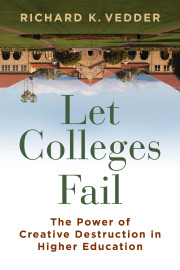Why the outburst of campus protests in recent years, culminating in the sizable and sometimes violent demonstrations at such prestigious universities as Harvard, Columbia, Northwestern, and Stanford? While many factors are at work, one that seldom gets mentioned: boredom. Students often have a lot of free time. TikTok, Instagram, drinking, sex, and internet porn do not provide adequate fulfillment.
Why? Most college students don’t have much to do academically. Why is that? Grade inflation. Surveys of time use by the federal government suggest that the amount of time college kids spend on their academic work has fallen from an average of perhaps 40 hours weekly in the middle of the last century to about 27 or so hours today. Since a “year” in American collegiate parlance is actually only about 32 or so weeks, college students probably average less than 900 hours annually working on school tasks, probably less than much younger elementary or high school students—and less than half as much as the highly productive professional, technical, or managerial workers that most college students aspire to be.
Harvard’s great political scientist Harvey Mansfield has taught in every decade since the 1960s—seven in total (as have I). In a great recent interview in the Wall Street Journal, Mansfield recalls how students do far less reading and writing in class than they did decades ago—but for much higher grades. Mansfield taught at the oldest and most elite of our colleges, while I had very similar experiences, teaching a bit at highly selective schools, but mostly at a very typical high mid-quality state institution with only moderately selective admission criteria, Ohio University. When I started teaching American economic history in the 1960s, students were expected to read a textbook and about five other supplemental books. In my last years of teaching (until a couple of years ago), I considered it an accomplishment if students read the text and maybe a couple of short supplemental readings. Looking at old gradebooks, in the mid-1960s, my average grade in an introductory economics class was a “C” and it was rare for even 10 percent of students to get an “A.” Mansfield notes that a majority of grades today at schools like Harvard are “A” or “A-.” Nearly all students wrongly consider themselves Masters of the Universe.
The grade system provides vital information not only to the universities themselves but to future employers wishing to separate the best and brightest from the mediocre and mundane. If everyone gets nearly the same grades, their informational value is virtually lost. Student incentives to work hard are dramatically reduced, allowing them time to form campus encampments and demonstrate for days over events occurring thousands of miles away that only very tangentially touch on their lives.
A major factor in the rise of grade inflation probably was the introduction of institutionally administered student evaluations of professors on most campuses in the late 1960s or 1970s. In an attempt to make colleges more comforting and responsive to students in order to avoid unwanted campus discontent, college administrators initiated evaluations that at many schools were perceived by the professoriate to have some importance—bad evaluations sometimes severely reduced the prospects for tenure, for example. By giving high grades, professors thought that could buy some popularity and indirectly job security.
I believe the increased role of the federal government has lowered the quality of American higher education materially in the last half century or so, but a case could be made that schools receiving federal financial support should not be allowed to have average cumulative grade point averages above 3.0 (“B”) for the undergraduate student body (exceptionally good students could still get near 4.0 averages). State governments could do the same for the universities they subsidize. Another approach would be to introduce a “grade inflation tax” whereby schools would lose a proportion of subsidies—including research support, Pell Grants, etc.,—if the accumulative grade point average of all undergraduates exceeded a “B” average. Collegiate apparatchiks, in turn, would have to harass or incentivize faculty into making the grading system useful again.
To be sure, there are other factors involved in today’s campus protests, and one can legitimately argue that peaceful protests that do not interfere substantially with the pursuit of knowledge and discovery of truths are actually good—signs of a vibrant campus with a considerable diversity of views and members of the university community interested in the broader world. The protests of the Vietnam War era, for example, occurred when grade inflation was dramatically lower. But students today are not challenged by their academic duties enough, leading to such modern phenomenon as excessive time spent on social media rather than learning the verities contributing to prosperous and long lives. College should be more than four or five “gap years” of fun between secondary school and the “real world.”













